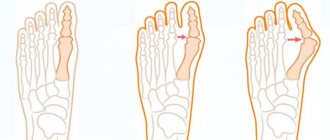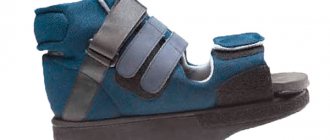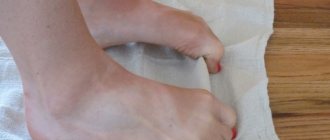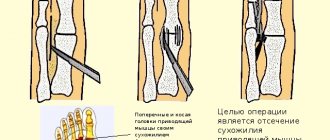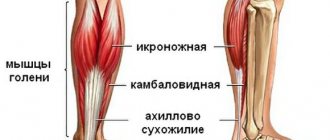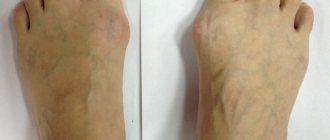- About Hallux Valgus
- Degrees of Hallux Valgus
- Treatment of Hallux Valgus
- Operations for Hallux Valgus
- Video reviews about the treatment of Hallux Valgus
Our center specializes in the treatment of toe deformities. Numbers:
- 16 years of experience
- 803 operations performed
- 580 of which free of charge within the framework of the VMP
- 97 % gained freedom in choosing shoes
What is Hallux Valgus
Hallux Valgus is a Latin term used when there is a pathological deviation of the first toe outward. This forefoot deformity, hallux valgus, is quite common among women, but can also occur in men.
There are many reasons for the development of this deformation. The most common hereditary nature of the disease. The basis for valgus deviation of the first toe is the development of longitudinal-transverse flatfoot, i.e. flattening of the longitudinal and transverse arches of the foot, which sharply disrupts the biomechanical relationships in the joints of the entire foot when walking and triggers a chain of pathological processes, which in turn leads, first, to the development of compensatory processes, then decompensation.
The development of forefoot deformity is facilitated by so-called predisposing factors, which most often include:
- overweight,
- wearing narrow high-heeled shoes,
- long-term static loads on the feet, etc.
Claw-shaped toes
According to physiological standards, flexion and extension of the phalanges in the joints can be controlled, but with this pathology the finger is bent and there is no ability to straighten it independently.
The etiology of the disease is a dysfunction of the muscular system. Flat feet, injuries or cerebral palsy are predisposing factors of the pathology.
Symptoms of deformation:
- Inability to wear high-heeled shoes (discomfort, pain when walking);
- The appearance of calluses and ulcers on the fingers and feet;
- Pain when trying to straighten the finger.
The diagnosis is made on the basis of an x-ray and external examination of the foot: arthritis, traumatic fracture or dislocation are excluded.
Important!
If left untreated, the deformity can progress: the second leg is affected, so to prevent pathology, radiography of both feet is performed.
Conservative therapy after confirmation of the diagnosis consists of changing shoes: it is necessary to choose models without heels, with a loose nose, and made from natural materials.
It is acceptable to use orthopedic devices to straighten the fingers while maintaining joint mobility.
Surgical intervention is carried out with complete limitation of the joints and consists of arthroplasty (restoration of the anatomical shape of the joint).
If arthroplasty is not possible, the affected joint is removed and the foot bones are fixed with titanium pins.
Claw toes symptoms
Degrees of Hallux Valgus
There are several degrees of Hallux valgus. The degree of hallux valgus is determined by changing the angle between the first toe and the first metatarsal bone - Hallux valgus angle. An important value for determining the degree of Hallux valgus is the so-called intermetatarsal angle , the angle between the first and second metatarsal bones. Depending on the magnitude of these angles, they are distinguished. 3 degrees of valgus deviation of the first finger - Hallux valgus
| first toe valgus angle | intermetatarsal angle |
The presented table shows the values of the angles and the degree of valgus deformation of the first finger corresponding to it:
| I degree | II degree | III degree | |
| Intermetatarsal angle | <12° | <18° | >18° |
| Hallux valgus angle | <25° | >25° | >35° |
Each degree of Hallux Valgus has its own clinical manifestations . The main symptom of hallux valgus is the outward deviation of the first toe - Hallux Valgus. Patients are also concerned about pain in the area of the first metatarsophalangeal joint, where they note an enlarged bone, swelling of the joint, and redness of the skin in the area of this joint. Subsequently, the so-called transversely spread foot is formed, which is not capable of performing the function of a shock absorber of body weight. Thus, a persistent pathological deformity of the forefoot develops. The tactics and approaches to treating Hallux Valgus certainly depend on the degree of deformation and clinical manifestations.
Treatment of hallux valgus at the Miracle Doctor clinic
The Miracle Doctor clinic performs surgery to treat hallux valgus using the McBride method. It allows you to eliminate transverse flatfoot and curvature of the finger without fracture, implantation of metal structures, or application of plaster casts.
This technique has several varieties, and the method of treatment is selected by the doctor individually based on the X-ray images obtained.
Advantages of the technique
- The patient can walk the very next day after surgery.
- The recovery period takes no more than 4 weeks.
- After completing rehabilitation, women are allowed to wear high-heeled shoes.
- The duration of the operation is short – from 1 to 1.5 hours.
- Gentle anesthesia.
- Possibility of treating two feet at once.
- The length of hospital stay after surgery is no more than 1 day.
- No postoperative complications.
- Excellent cosmetic effect.
After rehabilitation there are no restrictions on heel height.
The stitches can be removed at your local clinic, but he will need to return for a follow-up appointment and check-up 6 weeks after surgery.
Rehabilitation after surgery
The rehabilitation time depends on the stage of the disease, but does not take more than 3-4 weeks. After the procedure, you must stay in Moscow for 5-7 days, it is advisable to have an accompanying person. Full load on the lower limbs is possible 7-10 days after the intervention.
It is very important to do everything gradually and carefully, since during the course of the disease the patient loses the ability to correctly accept three points of support. For the maximum effect of treatment, restorative gymnastics, strengthening exercises and drug therapy are needed to accelerate the recovery of the articular-ligamentous apparatus.
Treatment of Hallux Valgus
Video - performing an operation for Hallux Valgus, 1:49 min, 3 MB.
In most cases, in the initial stages of the disease, the first treatment option for Hallux Valgus is conservative treatment , which includes:
- lifestyle correction (loss of body weight, exercise, etc.)
- the use of orthopedic shoes to eliminate interaction in the area of the first metatarsophalangeal joint - in the area of the “painful bump”,
- use of interdigital spacers
- using orthopedic orthoses for the first toe.
- the use of insoles that correct the arches of the feet.
Drug treatment often includes drugs from the group of non-steroidal anti-inflammatory drugs and physiotherapeutic procedures. If several courses of conservative treatment are ineffective or in advanced stages of the disease, surgical treatment of hallux valgus is used.
Surgery for Hallux Valgus is performed free of charge as part of the VMP
If there are medical indications and there are referral quotas, our center performs operations using funds allocated under the program for the provision of high-tech medical care (HTMC)
Details about the high-tech medical care program
Diagnostics
Diagnosis is carried out in stages:
- A specialist (orthopedic traumatologist) studies the medical history. When interviewing the patient, the doctor clarifies the symptoms, as well as the presence of factors that provoke the appearance of pain (physical activity, incorrectly selected shoes, frequent and intense walking), it becomes clear whether there were mechanical injuries, whether there are systemic, metabolic, genetic or orthopedic diseases, etc. .
- A general external examination, during which the doctor analyzes the characteristics of the patient’s gait, determines disturbances in it and the intensity of pain during walking, looks at the location of the big toe relative to the rest (identifying sprains of the articular ligaments), finds out if there is swelling or redness (if any - This means that the shoes are chosen poorly and are squeezing). Next, the specialist checks the range of motor activity in the metatarsophalangeal joint (in the normal state, the angle of backward flexion is 65-75°, and the angle of plantar flexion is less than 15°), the presence of pain and crepitus. Painful sensations in the absence of crunching indicate inflammation of the synovium (synovitis), and a thickened stratum corneum (keratosis) is a sign of rubbing due to improper gait. In addition, the doctor examines disturbances in the movement of the first toe, skin, and peripheral pulse.
If necessary, radiography is prescribed, which allows one to judge the degree of deformation, as well as the presence or absence of joint subluxation and associated pathologies.
To exclude circulatory disorders, a vascular ultrasound is performed. To identify associated diseases, as well as in preparation for surgery, laboratory tests and MRI may be prescribed.
Operations for Hallux Valgus
Currently, a huge number of different methods of surgical treatment of Hallux Valgus are known, which indicates an unresolved problem and the absence of a universal method for treating this deformity. The most widely used techniques involve performing various osteotomies of the metatarsal bone and the main phalanx of the first toe. These techniques often make it possible to achieve the desired correction of deformity in Hallux Valgus, and to allow the patient to leave the hospital bed in a short time after surgery. In most cases, when using modern treatment methods, patients do not have plaster immobilization of their feet and there is no need to use additional support - crutches.
Patient Irina, 47 years old. Photos of feet before and after Hallux Valgus treatment
Patient Olga, 62 years old. Photos of feet before and after Hallux Valgus treatment
Video reviews about the treatment of toe deformities in our center
Patient Saurina E.L. — surgery for Hallux Valgus Patient Burkova E.D. — surgery for Hallux Valgus Patient Shestakova S. — surgery for bunions Zdorina T.V. 45 years old - removal of bones on the legs
Video about treatment of Hallux Valgus
Pavel Zhadan about the treatment of Hallux Valgus on the TVC channel
On April 18, 2013, the TVC channel aired the program “Doctor I” in which the orthopedic traumatologist P.L. Zhadan took part. The program touched upon the topic of treatment of flat feet and one of the most common orthopedic pathologies of the forefoot - hallux valgus. The program covered the causes of static foot deformities, prevention and modern methods of treating patients with this orthopedic pathology. We recommend watching the full version of the program on our website.
Transverse flatfoot
A decrease in the length of the foot and deformation of the toes (divergence of the metatarsal bones) is characteristic of transverse flatfoot. The disease is more common in women aged 35-50, who prefer high heels and are forced to spend long periods of time on their feet. A hereditary predisposition to flat feet cannot be ruled out.
The degree of development of the disease is determined by the angle between the first metatarsal bone and the first toe:
- Weakly expressed flat feet (angle does not exceed 20 degrees);
- Moderately severe flat feet (angle 20-35 degrees):
- A pronounced degree of pathology (angle more than 35 degrees).
The main clinical symptom of the disease is aching pain during movement, which ceases at rest. More often, the reason for visiting a doctor is a pronounced cosmetic defect, when the first metatarsophalangeal joint becomes inflamed, corns and skin growths appear, and the foot becomes flattened.
Drug therapy is effective in the first stage of flat feet: weight control is carried out or measures are taken to reduce it, the patient is selected for shoes without heels with special bolsters or insoles.
As the disease progresses, surgery is performed: plastic surgery of the joint capsule, partial removal of bone structures and tendon transplantation.
Important!
During the rehabilitation period, it is necessary to use shoes with arch supports and insoles, and limit physical activity.
Prevention
The main preventive measure is systematic examinations by an orthopedic traumatologist, especially if the patient has factors contributing to the disease. In addition, women should avoid wearing high heels all the time because... this leads to the appearance of flat feet, and subsequently to valgus deformity.
For people who work on their feet, it is important to maintain certain periods of rest and, if necessary, use orthopedic shoes or insoles.
In addition, regular barefoot walking is a good preventive measure, as this trains the muscles and tendons of the lower extremities.
